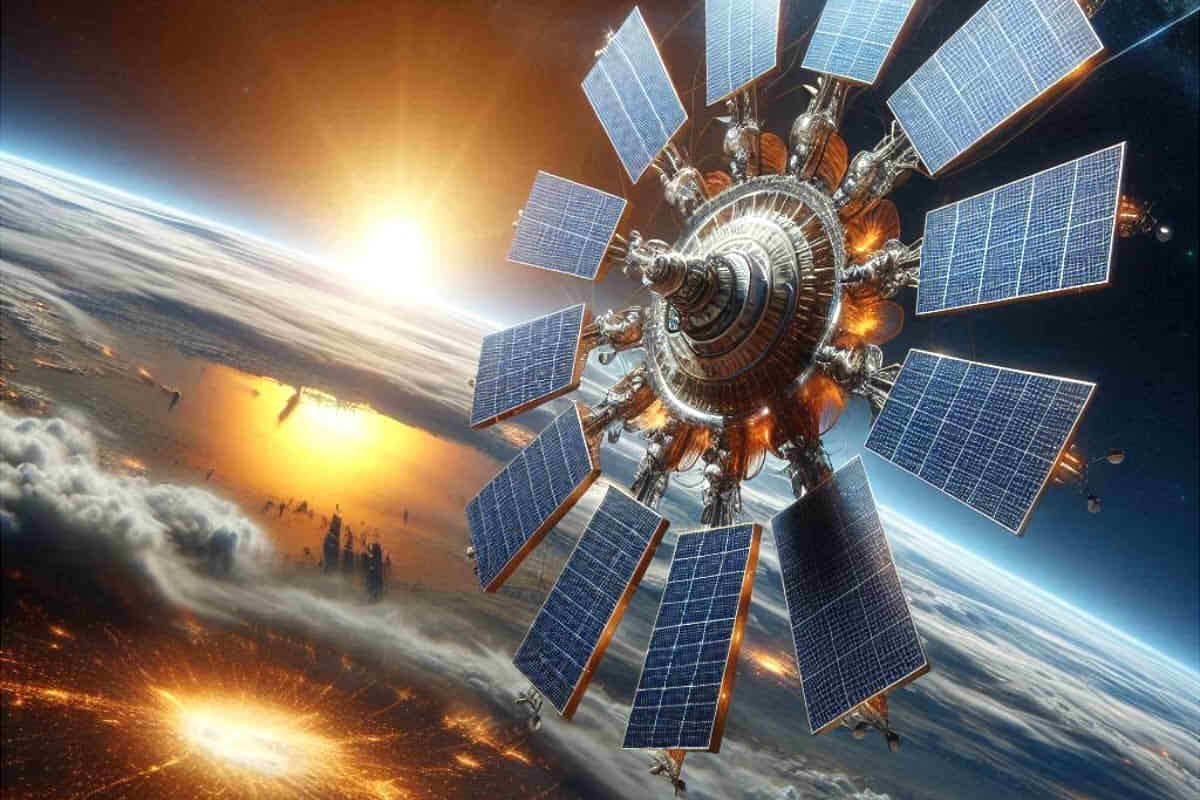Stellen Sie sich einen Ort vor, an dem die Sonne nie untergeht, wo Wolken den Himmel nicht verdecken, und wo die Sonnenstrahlen intensiver sind als alles, was wir auf der Erde erleben. Dieser Ort ist keine Science-Fiction – es ist der Weltraum, Eine Grenze, die der Schlüssel zur Revolutionierung der Art und Weise sein könnte, wie wir Solarenergie erzeugen und nutzen.
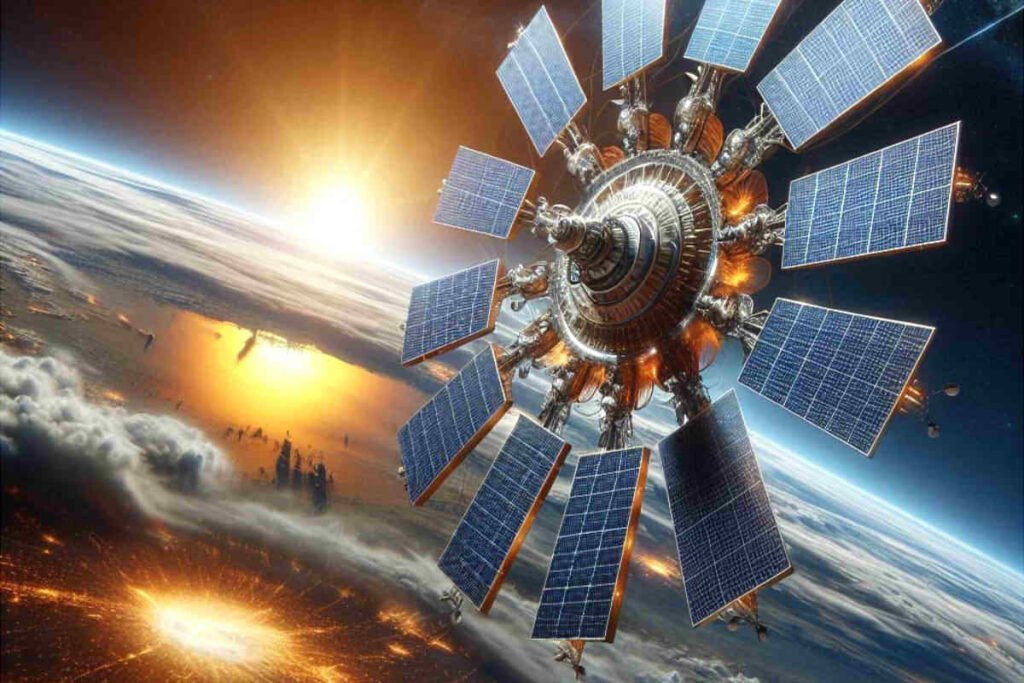
Während die Welt auf dem Weg zu erneuerbaren Energielösungen ist, Solarenergie hat sich zu einem Schlüsselfaktor im Streben nach einer nachhaltigen Zukunft entwickelt. Auf der Erde, Sonnenkollektoren säumen Dächer und Felder, Wir wandeln Sonnenlicht in Strom um, der unsere Häuser mit Strom versorgt, Unternehmen, und Technologien. Aber was wäre, wenn wir Solarenergie über die Grenzen unseres Planeten hinaus in den Weltraum bringen könnten?? Jetzt, Lassen Sie uns untersuchen, ob Solarenergie im Weltraum effektiver sein könnte.
Inhaltsverzeichnis
- Prinzipien der Stromerzeugung durch Solarmodule
- Vorteile der Solarstromerzeugung im Weltraum
- Tatsächliche Installationen, die Solarenergie im Weltraum genutzt haben
- Herausforderungen und Gegenmaßnahmen für die Solarstromerzeugung im Weltraum
- Die Zukunft der Solarenergie im Weltraum
- Abschluss: Wäre Solarenergie im Weltraum effektiver??
Prinzipien der Stromerzeugung durch Solarmodule
Wie Solarmodule funktionieren
Das Herzstück der Solarstromerzeugung ist die Photovoltaik (PV) Zelle, eine Technologie, die Sonnenlicht direkt in Strom umwandelt. Wenn Sonnenlicht auf die PV-Zelle trifft, Es regt Elektronen im Material – normalerweise Silizium – an, wodurch sie sich bewegen und einen elektrischen Strom erzeugen. Dieser Prozess, bekannt als die Photovoltaischer Effekt, ermöglicht es Solarpaneelen, aus Sonnenlicht Strom zu erzeugen.
PV-Zellen werden zu einem Solarpanel verbunden, und mehrere Module können miteinander verbunden werden, um eine Solaranlage zu bilden. Der erzeugte Strom liegt in Form von Gleichstrom vor (DC), die in bestimmten Anwendungen direkt eingesetzt werden können. Oder es kann auf Wechselstrom umgestellt werden (Wechselstrom) und über ins Netz übertragen Oberleitungen oder Erdkabel für den häuslichen und industriellen Gebrauch.
Arten von Solarmodulen
Es gibt verschiedene Arten von Solarmodulen, jedes mit seinen eigenen Eigenschaften und Effizienzen:
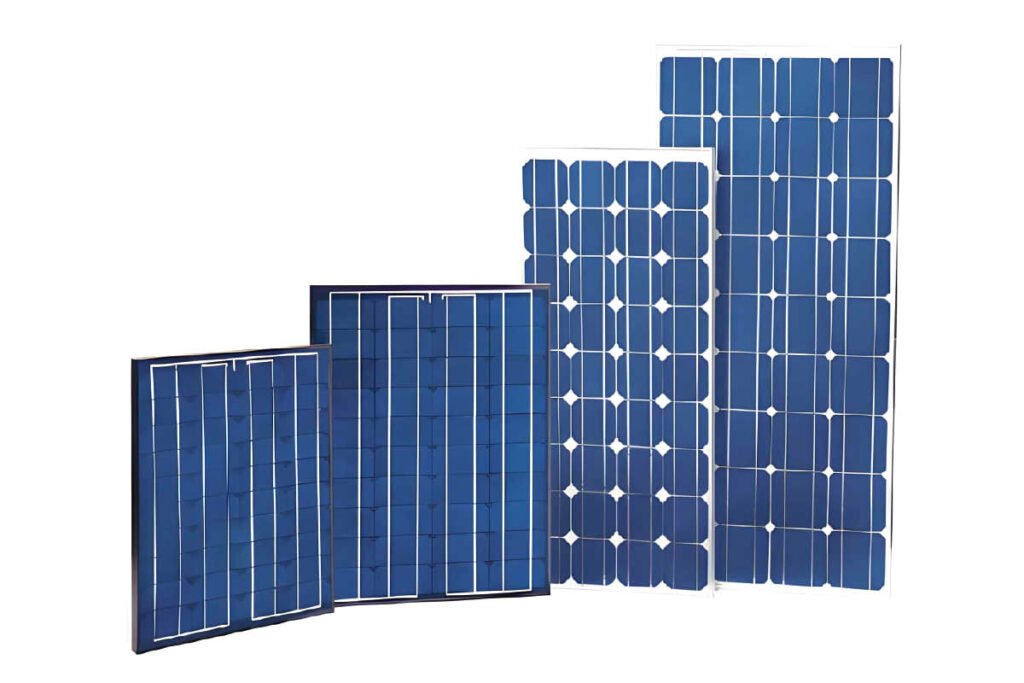
- Monokristalline Panels: Aus einem Stück gefertigt, reine Kristallstruktur, Diese Panels sind für ihre hohe Effizienz und lange Lebensdauer bekannt. Sie sind oft teurer, bieten aber eine bessere Leistung, insbesondere bei schlechten Lichtverhältnissen.
- Polykristalline Panels: Diese Panels bestehen aus mehreren Siliziumkristallen und sind im Allgemeinen weniger effizient als monokristalline Panels. Jedoch, Sie sind günstiger und bieten dennoch zuverlässige Leistung.
- Dünnschichtplatten: Erstellt durch Abscheiden einer oder mehrerer dünner Schichten photovoltaischen Materials auf einem Substrat, Dünnschichtplatten sind leicht und flexibel. Sie haben im Vergleich zu kristallinen Modulen einen geringeren Wirkungsgrad, können aber aufgrund ihrer Vielseitigkeit in einem breiteren Anwendungsspektrum eingesetzt werden.
Jeder Solarmodultyp hat seinen Platz auf dem Solarenergiemarkt, Die Auswahl hängt oft von den spezifischen Projektanforderungen ab, Budget, und Platzverfügbarkeit.
Vorteile der Solarstromerzeugung im Weltraum
Während Sonnenkollektoren auf der Erde sehr effektiv sind, Sie unterliegen aufgrund der Atmosphäre des Planeten Einschränkungen. Im Weltraum, Jedoch, Solarmodule könnten in einer Umgebung ohne diese atmosphärischen Störungen betrieben werden. Dies bedeutet, dass die Solarstromerzeugung im Weltraum das Potenzial hat, weitaus effizienter und zuverlässiger zu sein als auf der Erde.
Ständige Sonneneinstrahlung
Einer der bedeutendsten Vorteile der Erzeugung von Solarenergie im Weltraum ist die Möglichkeit einer ständigen Sonneneinstrahlung. Anders als auf der Erde, wo der Tag-Nacht-Zyklus die Solarstromerzeugung auf die Tageslichtstunden beschränkt, Bestimmte Umlaufbahnen im Weltraum bieten nahezu ununterbrochenen Zugang zu den Sonnenstrahlen. Geostationäre und polare Umlaufbahnen, Zum Beispiel, kann kontinuierliches Sonnenlicht liefern, vor allem bei richtiger Positionierung. Dies bedeutet, dass Sonnenkollektoren im Weltraum rund um die Uhr funktionieren könnten, Bereitstellung einer stabilen und zuverlässigen Energiequelle ohne Unterbrechungen durch Einbruch der Dunkelheit oder saisonale Veränderungen.
Zusätzlich, Weltraumgestützte Solaranlagen werden nicht von den Wetterbedingungen beeinflusst. Wolken, Regen, und Schnee, Dies kann die Wirksamkeit von Sonnenkollektoren auf der Erde erheblich verringern, sind im Weltraum nicht vorhanden. Dadurch wird sichergestellt, dass die Solarmodule ihre volle Leistung erbringen können, Maximierung der Energieproduktion.
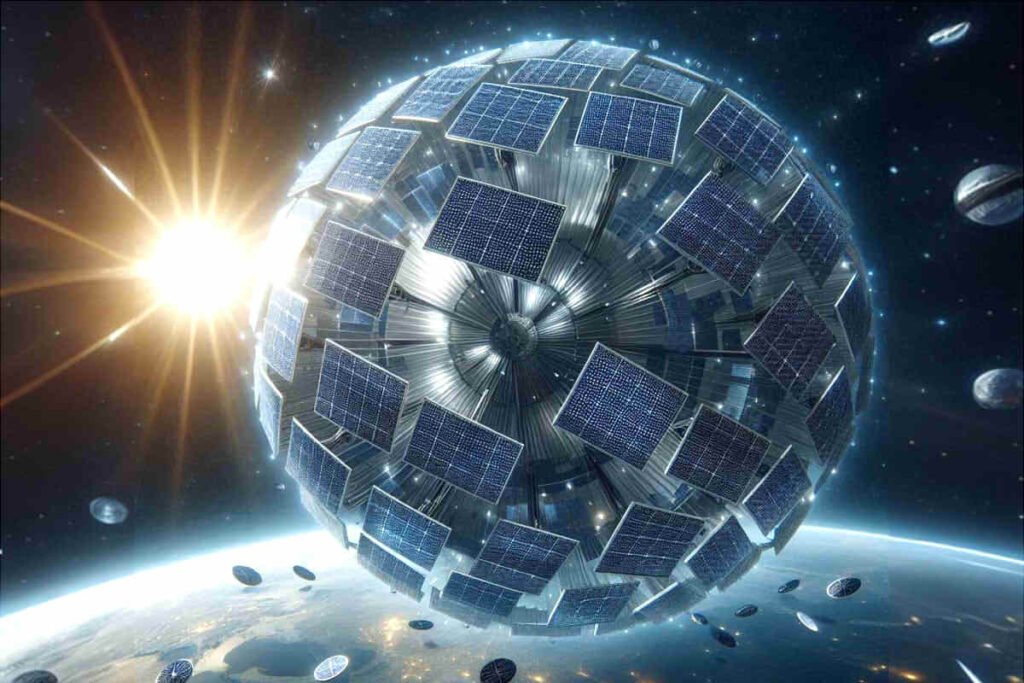
Höhere Sonneneinstrahlung
Ein weiterer großer Vorteil ist das Fehlen einer Atmosphäre im Weltraum: höhere Sonneneinstrahlung. Auf der Erde, Die Atmosphäre absorbiert und streut einen Teil des Sonnenlichts, bevor es die Oberfläche erreicht, Reduzierung der Energiemenge, die von Solarmodulen erfasst werden kann. Im Weltraum, Jedoch, Das ist kein Problem. Außerhalb der Erdatmosphäre positionierte Sonnenkollektoren empfangen die volle Intensität der Sonnenstrahlung, Das ist ungefähr 55% höher als das, was die Erdoberfläche erreicht.
Diese Erhöhung der Verfügbarkeit von Sonnenenergie bedeutet, dass Sonnenkollektoren im Weltraum im Vergleich zu ihren Gegenstücken auf der Erde mehr Strom auf derselben Fläche erzeugen können. Diese höhere Effizienz ist ein Schlüsselfaktor dafür, weltraumgestützte Solarenergie zu einer attraktiven Option für zukünftige Energielösungen zu machen.
Potenzial für größere Installationen
Der Weltraum bietet praktisch unbegrenzte Flächen für Solarstromanlagen, nicht an die Landbeschränkungen gebunden, die große Solarparks auf der Erde einschränken. Auf unserem Planeten, Aufgrund konkurrierender Landnutzungen kann es schwierig sein, geeignete Standorte für ausgedehnte Solaranlagen zu finden, geografische Einschränkungen, und Umweltbedenken. Im Weltraum, Diese Probleme gibt es nicht.
Im Weltraum könnten große Solarparks errichtet werden, Nutzen Sie die riesigen Flächen und die optimale Positionierung, um die Energiegewinnung zu maximieren. Diese Anlagen könnten so konzipiert sein, dass sie Sonnenenergie in einem Ausmaß nutzen, wie es auf der Erde nicht möglich wäre, potenziell große Energiemengen für verschiedene Zwecke liefern, einschließlich der Rückübertragung von Energie zur Erde oder der Stromversorgung zukünftiger Weltraummissionen und Lebensräume.
Tatsächliche Installationen, die Solarenergie im Weltraum genutzt haben
Internationale Raumstation (ISS)
Eines der bekanntesten Beispiele für die Nutzung von Solarenergie im Weltraum ist die Internationale Raumstation (ISS). Die ISS ist mit großen Solaranlagen ausgestattet, die fast alle ihrer Systeme mit Strom versorgen. Diese Arrays, überspannend 2,500 Quadratmeter, sollen Sonnenlicht einfangen und in Strom umwandeln, Dieses wird dann in Batterien gespeichert, um es in Zeiten zu nutzen, in denen sich die Station im Erdschatten befindet.
Die Solarmodule der ISS gehören zu den fortschrittlichsten, die jemals gebaut wurden, Einsatz hocheffizienter Photovoltaikzellen zur Maximierung der Energieerzeugung. Diese Paneele sind außerdem auf eine hohe Haltbarkeit ausgelegt, mit der Fähigkeit, den rauen Bedingungen im Weltraum standzuhalten, einschließlich extremer Temperaturen und Strahlenbelastung. Der Erfolg des Solarenergiesystems der ISS zeigt, dass die Nutzung von Solarenergie für Langzeitmissionen im Weltraum machbar ist.
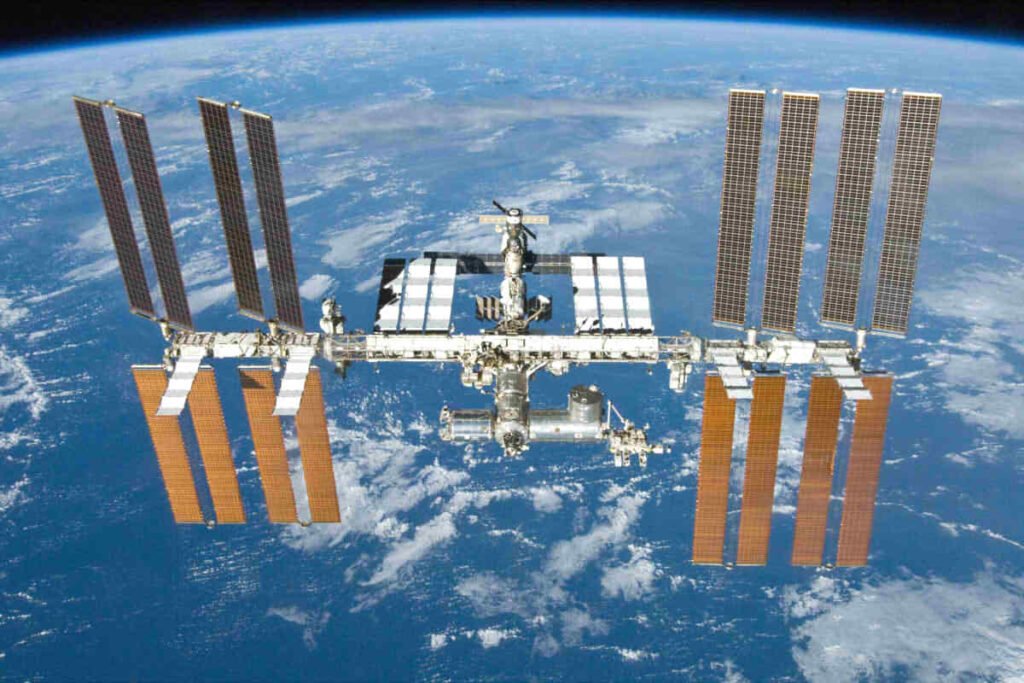
Satelliten
Solarenergie ist seit Jahrzehnten ein wesentlicher Bestandteil der Stromversorgung von Satelliten. Von Kommunikationssatelliten bis hin zu wissenschaftlichen Sonden, Sonnenkollektoren stellen eine zuverlässige und effiziente Energiequelle für diese wichtigen weltraumgestützten Technologien dar. Satelliten sind häufig mit Sonnenkollektoren ausgestattet, die von ihrem Körper ausgehen, Sonnenlicht sammeln und in Strom umwandeln, um Bordinstrumente anzutreiben, Kommunikationssysteme, und Antriebsmechanismen.
Zum Beispiel, das Hubble-Weltraumteleskop, der seitdem die Erde umkreist 1990, verlässt sich beim Betrieb seiner hochentwickelten Bildgebungssysteme auf Solarpaneele. Ähnlich, die Marsrover, allerdings nicht im Weltraum, nutzen Solarenergie, um ihre Missionen auf der Marsoberfläche aufrechtzuerhalten. Der Einsatz von Sonnenkollektoren auf Satelliten und anderen Weltraummissionen unterstreicht die Vielseitigkeit und Wirksamkeit der Solarenergie im Weltraum, wo traditionelle Energiequellen wie fossile Brennstoffe wahrscheinlich keine dauerhaftere Lösung darstellen.
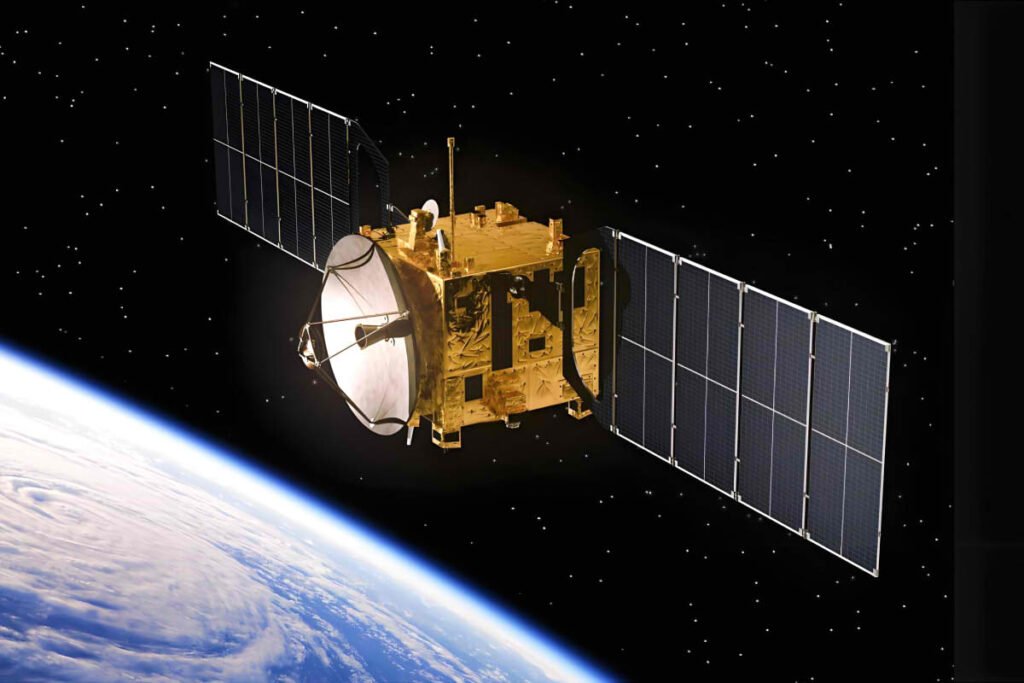
Vorgeschlagene weltraumgestützte Solarkraftwerke
Während die ISS und Satelliten die aktuelle Nutzung von Solarenergie im Weltraum demonstrieren, Es gibt ehrgeizige Vorschläge für noch größere Anlagen: weltraumgestützte Solarkraftwerke (SBSP). Diese Stationen würden in einer Umlaufbahn um die Erde positioniert und mit riesigen Solarpaneelen ausgestattet sein, viel größer als alles, was derzeit verwendet wird. Die Idee ist, Sonnenenergie im Weltraum einzufangen, wo es reichlicher und ununterbrochener ist, und diese Energie dann über Mikrowellen oder Laserstrahlen zurück zur Erde übertragen.
Mehrere Raumfahrtagenturen und private Unternehmen erkunden das Potenzial von SBSP, in Anerkennung seiner Fähigkeit, eine kontinuierliche und erneuerbare Energiequelle bereitzustellen, die die Abhängigkeit von fossilen Brennstoffen erheblich reduzieren könnte. Allerdings noch im konzeptionellen und experimentellen Stadium, Diese Projekte stellen einen bedeutenden Schritt hin zur großflächigen Nutzung weltraumgestützter Solarenergie dar.
Zu den bemerkenswerten Vorschlägen gehört das japanische Weltraum-Solarenergiesystem (SSPS) und Projekte von Organisationen wie der NASA und der Europäischen Weltraumorganisation (ESA). Diese Projekte sehen riesige Solaranlagen vor, möglicherweise kilometerweit, Sonnenlicht im Weltraum einfangen und Energie an erdbasierte Empfänger übertragen. Es bleiben zwar Herausforderungen bestehen, wie etwa die Bereitstellungskosten und die Effizienz der Energieübertragung, Diese Projekte könnten den Weg für die Zukunft der Solarenergie im Weltraum ebnen.
Herausforderungen und Gegenmaßnahmen für die Solarstromerzeugung im Weltraum
Raue Umweltbedingungen
Der Weltraum stellt die Solarstromerzeugung vor mehrere schwierige Umweltherausforderungen, die angegangen werden müssen, um die Langlebigkeit und Effizienz von Solaranlagen sicherzustellen.
- Strahlungsbelastung: Sonnenkollektoren im Weltraum sind intensiver kosmischer Strahlung ausgesetzt, einschließlich hochenergetischer Teilchen von der Sonne und anderen Quellen. Diese Strahlung kann Photovoltaikzellen im Laufe der Zeit schädigen, ihre Effizienz und Lebensdauer verringern. Um dem entgegenzuwirken, Ingenieure entwickeln fortschrittliche Abschirmmaterialien und Beschichtungen, um Solarmodule vor Strahlung zu schützen, ohne ihre Leistung zu beeinträchtigen. Zusätzlich, Die Verwendung strahlungsbeständiger Materialien beim Bau von Solarmodulen ist entscheidend für die Gewährleistung ihrer Haltbarkeit im Weltraum.
- Temperaturextreme: Im Weltraum, Solarmodule müssen extremen Temperaturschwankungen standhalten, von der sengenden Hitze direkter Sonneneinstrahlung bis zur eisigen Kälte schattiger Bereiche. Diese Temperaturschwankungen können zu thermischem Stress führen, Dies führt zu Materialermüdung und potenziellem Ausfall. Um dies anzugehen, Solarmodule bestehen aus Materialien, die großen Temperaturbereichen standhalten. Wärmekontrollsysteme, wie Heizkörper und Wärmerohre, werden auch eingesetzt, um die Temperatur zu regeln und eine Überhitzung oder übermäßige Abkühlung der Panels zu verhindern.
- Spezialkabel für die Energieübertragung: Rauminstallationen, die Übertragung von Energie von Solaranlagen zu anderen Komponenten erfordert spezialisierte Solarkabel. Diese Kabel müssen so ausgelegt sein, dass sie den rauen Bedingungen im Weltraum standhalten, einschließlich der Strahlenexposition, extreme Temperaturen, und die Vakuumumgebung. Außerdem müssen die Kabel leicht und dennoch langlebig sein, Gewährleistung einer zuverlässigen elektrischen Leitfähigkeit über lange Zeiträume. Fortschritte in der Materialwissenschaft tragen zur Entwicklung dieser Spezialkabel bei, die für den Erfolg und die Langlebigkeit weltraumgestützter Solarenergiesysteme von entscheidender Bedeutung sind.
Energieübertragung zur Erde
Die Übertragung der im Weltraum erzeugten Energie zurück zur Erde stellt eine große technologische Herausforderung dar, Es sind innovative Lösungen erforderlich, um weltraumgestützte Solarenergie in großem Maßstab möglich zu machen.
- Drahtlose Energieübertragung: Die vielversprechendste Methode zur Energieübertragung vom Weltraum zur Erde ist die drahtlose Energieübertragung. Dabei wird der von Sonnenkollektoren erzeugte Strom in Mikrowellen oder Laserstrahlen umgewandelt, die dann zu Empfangsstationen auf der Erde geleitet werden. An diesen Stationen, Die Energie wird wieder in Strom umgewandelt und ins Netz eingespeist. Während die Mikrowellenübertragung relativ fortschrittlich und effizient ist, Zu den Herausforderungen gehören die Aufrechterhaltung der Strahlgenauigkeit über große Entfernungen und die Minimierung des Energieverlusts während der Übertragung. Laserübertragung, obwohl es eine höhere Energiedichte bietet, steht vor Herausforderungen wie atmosphärischen Störungen und der Notwendigkeit einer präzisen Zielerfassung.
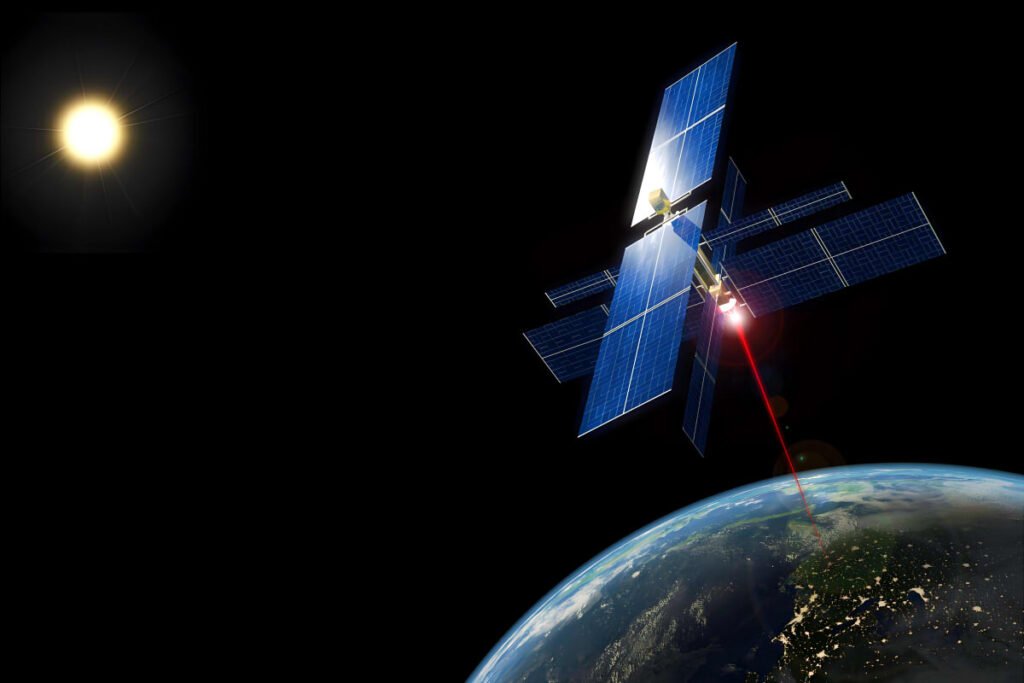
Wartung und Haltbarkeit
Die Gewährleistung der Haltbarkeit von Solarenergiesystemen im Weltraum und die Bewältigung der Schwierigkeiten bei der Wartung sind entscheidend für den langfristigen Erfolg.
- Mangel an Reparaturmöglichkeiten: Die Unfähigkeit, Komponenten im Weltraum einfach zu reparieren oder auszutauschen, ist eine große Herausforderung. Weltraummissionen sind kostspielig und komplex, Dadurch wird eine häufige Wartung unpraktisch. Um dies zu überwinden, Solarstromanlagen werden auf minimalen Wartungsaufwand und eine lange Lebensdauer ausgelegt. Dazu gehört der Einsatz selbstheilender Materialien, die kleinere Schäden autonom reparieren können, und die Entwicklung von Robotersystemen, die grundlegende Wartungsaufgaben im Weltraum durchführen können.
- Langlebige Materialien: Die Haltbarkeit von Solarmodulen und der dazugehörigen Ausrüstung ist entscheidend für die Realisierbarkeit weltraumgestützter Solarenergie. Materialien müssen einer Zersetzung durch Strahlung standhalten, Temperaturextreme, und das Vakuum des Weltraums. Innovationen bei fortschrittlichen Verbundwerkstoffen und Beschichtungen, beispielsweise solche, bei denen kohlenstoffbasierte Materialien wie Graphen zum Einsatz kommen, werden untersucht, um die Stärke zu erhöhen, Flexibilität, und Strahlungsbeständigkeit von Solarmodulen. Diese Fortschritte zielen darauf ab, Solarmodule zu schaffen, die jahrzehntelang betriebsbereit bleiben können, Reduzierung des Wartungs- und Austauschbedarfs.
Die Zukunft der Solarenergie im Weltraum
Weltraumgestützte Solarkraftwerke (SBSP)
Weltraumgestützte Solarkraftwerke (SBSP) stellen eines der ehrgeizigsten und vielversprechendsten Konzepte für die Zukunft der Solarenergie dar. Diese Stationen würden im Orbit um die Erde platziert, Ausgestattet mit riesigen Solarpaneelen, die das Sonnenlicht in einer Intensität einfangen sollen, die weit über das hinausgeht, was am Boden möglich ist. Die erzeugte Energie würde dann in Mikrowellen oder Laserstrahlen umgewandelt und zur Erde zurückgesendet, wo es von bodengestützten Empfängern erfasst und in Strom zur Verwendung im Stromnetz umgewandelt würde.
Die potenziellen Vorteile von SBSP sind immens. Sie könnten eine konstante und erneuerbare Energiequelle bereitstellen, unabhängig vom Wetter, saisonale Veränderungen, oder der Tag-Nacht-Zyklus. Diese kontinuierliche Energieversorgung könnte dazu beitragen, unsere Abhängigkeit von fossilen Brennstoffen zu verringern, einen wesentlichen Beitrag zum Kampf gegen den Klimawandel leisten. Zusätzlich, SBSP könnte in Gebieten eingesetzt werden, in denen der Zugang zu erneuerbaren Energiequellen begrenzt ist, Beitrag zur Behebung von Energieengpässen in abgelegenen oder unterversorgten Regionen.
Jedoch, Mehrere Herausforderungen müssen bewältigt werden, bevor SBSP Realität werden kann. Dazu gehören die hohen Kosten für den Start und die Wartung solch großer Strukturen im Weltraum, die technischen Schwierigkeiten bei der Übertragung von Energie über große Entfernungen, und die Notwendigkeit, die Sicherheit und Effizienz des Übertragungsprozesses zu gewährleisten. Kontinuierliche Forschung und Entwicklung in diesen Bereichen werden von entscheidender Bedeutung sein, um SBSP zu einer tragfähigen Lösung für die Zukunft zu machen.
Integration in das Energienetz der Erde
Damit weltraumgestützte Solarenergie zu einer praktischen Energiequelle wird, Es muss effektiv in das bestehende Energienetz der Erde integriert werden. Dabei geht es nicht nur um die Übertragung von Energie vom Weltraum zur Erde, sondern auch um die Verwaltung und Verteilung dieser Energie, sobald sie den Boden erreicht.
Die primäre Methode zur Energieübertragung aus dem Weltraum ist die drahtlose Energieübertragung, entweder über Mikrowellen oder Laser. Sobald die Energie einen bodengestützten Empfänger erreicht, Es muss wieder in Strom umgewandelt und ins Netz eingespeist werden Wechselstrom-Elektrokabel. Dieser Prozess erfordert fortschrittliche Technologien, um minimale Energieverluste zu gewährleisten und den Zeitpunkt und die Verteilung der Energie zu steuern.
Die Integration in das Stromnetz bedeutet auch, sicherzustellen, dass die im Weltraum erzeugte Energie mit den Energienachfragemustern der Erde kompatibel ist. Im Gegensatz zu herkömmlicher Solarenergie, der tages- und jahreszeitlichen Schwankungen unterliegt, Weltraumgestützte Solarenergie kann eine stetige Energieversorgung gewährleisten. Dies könnte dazu beitragen, das Netz auszugleichen und in Zeiten hoher Nachfrage oder wenn andere erneuerbare Energiequellen genutzt werden, ein zuverlässiges Backup bereitzustellen, wie Wind oder terrestrische Sonne, produzieren nicht mit voller Kapazität.
Fortschritte in der Weltraumtechnologie
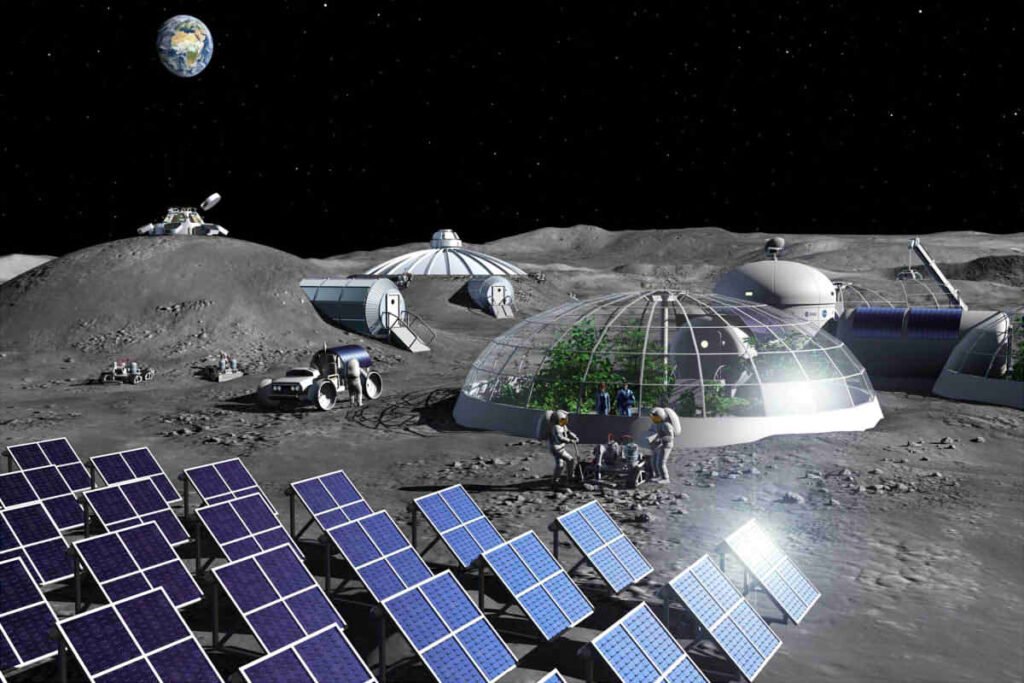
Die Zukunft der Solarenergie im Weltraum ist eng mit Fortschritten in der Weltraumtechnologie verbunden. Da die Raumfahrt praktikabler und kostengünstiger wird, Der Einsatz großer Solarkraftwerke im Orbit wird leichter möglich.
Innovationen in der Raketentechnologie, wie wiederverwendbare Raketen und effizientere Antriebssysteme, reduzieren die Kosten für den Start von Nutzlasten ins All. Dies macht den Einsatz und die Wartung weltraumgestützter Solaranlagen wirtschaftlicher. Zusätzlich, Fortschritte in der Robotik und Automatisierung werden den Bau und die Wartung von Solaranlagen im Weltraum mit minimalem menschlichen Eingriff ermöglichen, weitere Reduzierung der Kosten und Verbesserung der Zuverlässigkeit.
Darüber hinaus, Entwicklungen in der Materialwissenschaft und Nanotechnologie führen zur Entwicklung von Feuerzeugen, effizienter, und langlebigere Solarmodule. Diese Panels halten den rauen Bedingungen im Weltraum stand und maximieren gleichzeitig die Effizienz der Energiegewinnung und -umwandlung. Während sich diese Technologien weiterentwickeln, Die Machbarkeit weltraumgestützter Solarenergie wird zunehmen, Dies bringt uns einer Zukunft näher, in der im Weltraum gewonnene Solarenergie eine wichtige Rolle bei der Deckung des globalen Energiebedarfs spielt.
Mögliche Rolle bei der Bewältigung von Energiekrisen
Weltraumgestützte Solarenergie hat das Potenzial, eine transformative Rolle bei der Bewältigung globaler Energiekrisen zu spielen. Da die Weltbevölkerung wächst und der Energiebedarf steigt, Traditionelle Energiequellen werden immer stärker belastet. Fossile Brennstoffe sind endlich und tragen zur Umweltzerstörung bei, während terrestrische erneuerbare Energiequellen häufig durch geografische und Umweltfaktoren begrenzt sind.
Durch die Bereitstellung einer konstanten und praktisch unbegrenzten Quelle sauberer Energie, Weltraumgestützte Solarenergie könnte dazu beitragen, den Energiebedarf der Welt auf nachhaltige Weise zu decken. Dies könnte sich besonders in Regionen auswirken, in denen es derzeit keinen zuverlässigen Zugang zu Elektrizität gibt, Wir tragen dazu bei, die Energielücke zu schließen und die Lebensqualität von Millionen von Menschen zu verbessern.
Auf lange Sicht, Weltraumgestützte Solarenergie könnte auch zur Energiesicherheit beitragen, indem sie die Abhängigkeit von fossilen Brennstoffen verringert und den globalen Energiemix diversifiziert. Indem wir die Kraft der Sonne aus dem Weltraum nutzen, Die Menschheit könnte eine neue Grenze im Bereich der erneuerbaren Energien erschließen, den Weg für eine nachhaltigere und gerechtere Zukunft ebnen.
Abschluss: Wäre Solarenergie im Weltraum effektiver??
Die Frage, ob Solarenergie im Weltraum effektiver wäre als auf der Erde, ist zwingend, und die Antwort hängt weitgehend davon ab, wie wir es definieren “Wirksamkeit.”
Aus rein technischer Sicht, Solarenergie im Weltraum birgt erhebliche Vorteile. Da es keine Atmosphäre gibt, können Solarpaneele viel mehr Sonnenlicht einfangen, ununterbrochen vom Wetter, Wolken, oder der Tag-Nacht-Zyklus. Dies führt zu einer konstanten und möglicherweise viel höheren Energieausbeute im Vergleich zu terrestrischen Solarmodulen. Darüber hinaus, die Fähigkeit, große Solarparks im Weltraum zu bauen, frei von den Zwängen der Landnutzung, eröffnet Möglichkeiten zur Erzeugung enormer Energiemengen.
Jedoch, Zur Wirksamkeit gehören auch Überlegungen zur Machbarkeit, kosten, und Nachhaltigkeit. Momentan, die Herausforderungen, die mit der weltraumgestützten Solarenergie verbunden sind – beispielsweise die hohen Kosten für die Bereitstellung, die Komplexität der Energieübertragung zur Erde, und die Haltbarkeit von Materialien in rauen Weltraumumgebungen – sind erhebliche Hürden. Diese Herausforderungen müssen durch kontinuierliche Innovation und technologische Fortschritte bewältigt werden, bevor weltraumgestützte Solarenergie zu einer praktischen und kostengünstigen Lösung werden kann.
Auf lange Sicht, wenn die Technologie Fortschritte macht und die Kosten sinken, Weltraumgestützte Solarenergie könnte tatsächlich ein wirksameres Mittel zur Nutzung der Sonnenenergie werden. Es hat das Potenzial, eine kontinuierliche und reichlich vorhandene Quelle sauberer Energie bereitzustellen, Beitrag zur globalen Energiesicherheit und Nachhaltigkeit. Auch wenn wir möglicherweise noch Jahre davon entfernt sind, dieses Potenzial vollständig auszuschöpfen, Das Streben nach Solarenergie im Weltraum stellt eine spannende Herausforderung bei der Suche nach Lösungen für erneuerbare Energien dar.

